Upper Ocean Responses to Tropical Cyclone Mekunu (2018) in the Arabian Sea
Abstract
:1. Introduction
2. Materials and Methods
2.1. Observations
2.2. Model Simulation
2.3. Mixed Layer
2.4. Ekman Pumping Velocity
2.5. Heat Budget Equation
3. Results and Discussion
3.1. Validation of the Coupled Model Simulations
3.1.1. Track and Intensity of TC Mekunu
3.1.2. Ocean Thermohaline
3.2. Ocean Responses in the Coupled Model
3.2.1. Surface Current Responses
3.2.2. Mixed Layer Responses
3.2.3. Subsurface Responses
3.3. Role of the Pre-Existing Cold Eddy
3.3.1. Initial Ocean Conditions
3.3.2. Ocean Responses in the Uncoupled Model
3.3.3. Heat Budget Analysis
4. Conclusions
Author Contributions
Funding
Institutional Review Board Statement
Informed Consent Statement
Data Availability Statement
Acknowledgments
Conflicts of Interest
References
- Sahoo, B.; Bhaskaran, P.K. Assessment on historical cyclone tracks in the Bay of Bengal, east coast of India. Int. J. Climatol. 2016, 36, 95–109. [Google Scholar] [CrossRef]
- Singh, V.K.; Roxy, M.K. A review of ocean-atmosphere interactions during tropical cyclones in the north Indian Ocean. Earth-Sci. Rev. 2022, 226, 103967. [Google Scholar] [CrossRef]
- Kumar, S.P.; Roshin, R.P.; Narvekar, J.; Kumar, P.K.D.; Vivekanandan, E. Response of the Arabian Sea to global warming and associated regional climate shift. Mar. Environ. Res. 2009, 68, 217–222. [Google Scholar] [CrossRef] [PubMed]
- Murakami, H.; Vecchi, G.A.; Underwood, S. Increasing frequency of extremely severe cyclonic storms over the Arabian Sea. Nat. Clim. Chang. 2017, 7, 885–889. [Google Scholar] [CrossRef]
- Bell, S.S.; Chand, S.S.; Tory, K.J.; Ye, H.; Turville, C. North Indian Ocean tropical cyclone activity in CMIP5 experiments: Future projections using a model-independent detection and tracking scheme. Int. J. Climatol. 2020, 40, 6492–6505. [Google Scholar] [CrossRef]
- Price, J.F.; Sanford, T.B.; Forristall, G.Z. Forced Stage Response to a Moving Hurricane. Am. Meteorol. Soc. 1994, 24, 233–260. [Google Scholar] [CrossRef]
- Yang, B.; Hou, Y. Near-inertial waves in the wake of 2011 Typhoon Nesat in the northern South China Sea. Acta Oceanol. Sin. 2014, 33, 102–111. [Google Scholar] [CrossRef]
- Chen, G.; Xue, H.; Wang, D.; Xie, Q. Observed near-inertial kinetic energy in the northwestern South China Sea. J. Geophys. Res. Oceans 2013, 118, 4965–4977. [Google Scholar] [CrossRef]
- Kawaguchi, Y.; Yabe, I.; Senjyu, T.; Sakai, A. Amplification of typhoon-generated near-inertial internal waves observed near the Tsushima oceanic front in the Sea of Japan. Sci. Rep. 2023, 13, 8387. [Google Scholar] [CrossRef]
- Price, J.F. Upper Ocean Response to a Hurricane. J. Phys. Oceanogr. 1981, 11, 153–175. [Google Scholar] [CrossRef]
- Mei, W.; Pasquero, C. Spatial and Temporal Characterization of Sea Surface Temperature Response to Tropical Cyclones. J. Clim. 2013, 26, 3745–3765. [Google Scholar] [CrossRef]
- D’Asaro, E.A.; Sanford, T.B.; Niiler, P.P.; Terrill, E.J. Cold wake of Hurricane Frances. Geophys. Res. Lett. 2007, 34. [Google Scholar] [CrossRef]
- Mahapatra, D.K.; Rao, A.D.; Babu, S.V.; Srinivas, C. Influence of coast line on upper ocean’s response to the tropical cyclone. Geophys. Res. Lett. 2007, 34, L17603. [Google Scholar] [CrossRef]
- Huang, P.; Sanford, T.B.; Imberger, J. Heat and turbulent kinetic energy budgets for surface layer cooling induced by the passage of Hurricane Frances (2004). J. Geophys. Res. Oceans 2009, 114, 1–14. [Google Scholar] [CrossRef]
- Vincent, E.M.; Lengaigne, M.; Madec, G.; Vialard, J.; Samson, G.; Jourdain, N.C.; Menkes, C.E.; Jullien, S. Processes setting the characteristics of sea surface cooling induced by tropical cyclones. J. Geophys. Res. Oceans 2012, 117. [Google Scholar] [CrossRef]
- Zedler, S.E.; Dickey, T.D.; Doney, S.C.; Price, J.F.; Yu, X.; Mellor, G.L. Analyses and simulations of the upper ocean’s response to Hurricane Felix at the Bermuda Testbed Mooring site: 13–23 August 1995. J. Geophys. Res. Oceans 2002, 107, 25-1–25-29. [Google Scholar] [CrossRef]
- Emanuel, K. Contribution of tropical cyclones to meridional heat transport by the oceans. J. Geophys. Res. Atmos. 2001, 106, 14771–14781. [Google Scholar] [CrossRef]
- Sriver, R.L.; Huber, M. Observational evidence for an ocean heat pump induced by tropical cyclones. Nature 2007, 447, 577–580. [Google Scholar] [CrossRef] [PubMed]
- Pasquero, C.; Emanuel, K. Tropical Cyclones and Transient Upper-Ocean Warming. J. Clim. 2008, 21, 149–162. [Google Scholar] [CrossRef]
- Hart, R.E.; Maue, R.N.; Watson, M.C. Estimating Local Memory of Tropical Cyclones through MPI Anomaly Evolution. Mon. Weather Rev. 2007, 135, 3990–4005. [Google Scholar] [CrossRef]
- Park, J.J.; Kwon, Y.; Price, J.F. Argo array observation of ocean heat content changes induced by tropical cyclones in the north Pacific. J. Geophys. Res. Oceans 2011, 116. [Google Scholar] [CrossRef]
- Robertson, E.J.; Ginis, I. The Upper Ocean Salinity Response to Tropical Cyclones. Preprints. In Proceedings of the 25th Conference on Hurricanes and Tropical Meteorology, San Diego, CA, USA, 29 April–3 May 2002; American Meteorological Society: Boston, MA, USA, 2002. [Google Scholar]
- Girishkumar, M.S.; Suprit, K.; Chiranjivi, J.; Bhaskar, T.V.S.U.; Ravichandran, M.; Shesu, R.V.; Rao, E.P.R. Observed oceanic response to tropical cyclone Jal from a moored buoy in the south-western Bay of Bengal. Ocean Dyn. 2014, 64, 325–335. [Google Scholar] [CrossRef]
- Chaudhuri, D.; Sengupta, D.; Asaro, E.D.; Venkatesan, R.; Ravichandran, M. Response of the Salinity-Stratified Bay of Bengal to Cyclone Phailin. J. Phys. Oceanogr. 2019, 49, 1121–1140. [Google Scholar] [CrossRef]
- Qiu, Y.; Han, W.; Lin, X.; West, B.J.; Li, Y.; Xing, W.; Zhang, X.; Arulananthan, K.; Guo, X. Upper-Ocean Response to the Super Tropical Cyclone Phailin (2013) over the Freshwater Region of the Bay of Bengal. J. Phys. Oceanogr. 2019, 49, 1201–1228. [Google Scholar] [CrossRef]
- Chacko, N. Insights into the haline variability induced by cyclone Vardah in the Bay of Bengal using SMAP salinity observations. Remote Sens. Lett. 2018, 9, 1205–1213. [Google Scholar] [CrossRef]
- Mei, W.; Pasquero, C.; Primeau, F. The effect of translation speed upon the intensity of tropical cyclones over the tropical ocean. Geophys. Res. Lett. 2012, 39. [Google Scholar] [CrossRef]
- Dare, R.A.; McBride, J.L. Sea Surface Temperature Response to Tropical Cyclones. Mon. Weather Rev. 2011, 139, 3798–3808. [Google Scholar] [CrossRef]
- Behera, S.K.; Deo, A.A.; Salvekar, P.S. Investigation of mixed layer response to Bay of Bengal cyclone using a simple ocean model. Meteorog. Atmos. Phys. 1998, 65, 77–91. [Google Scholar] [CrossRef]
- Liu, Y.; Guan, S.; Lin, I.I.; Mei, W.; Jin, F.; Huang, M.; Zhang, Y.; Zhao, W.; Tian, J. Effect of Storm Size on Sea Surface Cooling and Tropical Cyclone Intensification in the Western North Pacific. J. Clim. 2023, 36, 7277–7296. [Google Scholar] [CrossRef]
- Elizabeth, A.I.; Effy, J.B.; Francis, P.A. On the upper ocean response of Bay of Bengal to very severe cyclones Phailin and Hudhud. J. Oper. Oceanogr. 2022, 15, 17–31. [Google Scholar] [CrossRef]
- Lin, S.; Zhang, W.; Shang, S.; Hong, H. Ocean response to typhoons in the western North Pacific: Composite results from Argo data. Deep. Sea Res. Part. I Oceanogr. Res. Pap. 2017, 123, 62–74. [Google Scholar] [CrossRef]
- Sun, J.; Vecchi, G.; Sodn, B. Sea Surface Salinity Response to Tropical Cyclones Based on Satellite Observations. Remote Sens. 2021, 13, 420. [Google Scholar] [CrossRef]
- Shay, L.K.; Goni, G.J.; Black, P.G. Effects of a Warm Oceanic Feature on Hurricane Opal. Mon. Weather Rev. 2000, 128, 1366–1383. [Google Scholar] [CrossRef]
- Jaimes, B.; Shay, L.K. Mixed Layer Cooling in Mesoscale Oceanic Eddies during Hurricanes Katrina and Rita. Mon. Weather Rev. 2009, 137, 4188–4207. [Google Scholar] [CrossRef]
- Ma, Z.; Fei, J.; Liu, L.; Huang, X.; Li, Y. An Investigation of the Influences of Mesoscale Ocean Eddies on Tropical Cyclone Intensities. Mon. Weather Rev. 2017, 145, 1181–1201. [Google Scholar] [CrossRef]
- Jacob, S.D.; Shay, L.K. The Role of Oceanic Mesoscale Features on the Tropical Cyclone–Induced Mixed Layer Response: A Case Study. J. Phys. Oceanogr. 2003, 33, 649–676. [Google Scholar] [CrossRef]
- Lu, Z.; Wang, G.; Shang, X. Response of a Preexisting Cyclonic Ocean Eddy to a Typhoon. J. Phys. Oceanogr. 2016, 46, 2403–2410. [Google Scholar] [CrossRef]
- Gordon, A.L.; Shroyer, E.; Murty, V.S.N. An Intrathermocline Eddy and a tropical cyclone in the Bay of Bengal. Sci. Rep. 2017, 7, 46218. [Google Scholar] [CrossRef]
- Sun, L.; Li, Y.X.; Yang, Y.J.; Wu, Q.; Chen, X.T.; Li, Q.Y.; Li, Y.B.; Xian, T. Effects of super typhoons on cyclonic ocean eddies in the western North Pacific: A satellite data-based evaluation between 2000 and 2008. J. Geophys. Res. Oceans 2014, 119, 5585–5598. [Google Scholar] [CrossRef]
- Zheng, Z.W.; Ho, C.R.; Kuo, N.J. Importance of pre-existing oceanic conditions to upper ocean response induced by Super Typhoon Hai-Tang. Geophys. Res. Lett. 2008, 35, L20603. [Google Scholar] [CrossRef]
- Yablonsky, R.M.; Ginis, I. Impact of a Warm Ocean Eddy’s Circulation on Hurricane-Induced Sea Surface Cooling with Implications for Hurricane Intensity. Mon. Weather Rev. 2012, 141, 997–1021. [Google Scholar] [CrossRef]
- Guan, S.; Liu, Z.; Song, J.; Hou, Y.; Feng, L. Upper ocean response to Super Typhoon Tembin (2012) explored using multiplatform satellites and Argo float observations. Int. J. Remote Sens. 2017, 38, 5150–5167. [Google Scholar] [CrossRef]
- Prakash, K.R.; Nigam, T.; Pant, V.; Chandra, N. On the interaction of mesoscale eddies and a tropical cyclone in the Bay of Bengal. Nat. Hazards 2021, 106, 1981–2001. [Google Scholar] [CrossRef]
- Warner, J.C.; Armstrong, B.; He, R.; Zambon, J.B. Development of a Coupled Ocean-Atmosphere-Wave-Sediment Transport (COAWST) Modeling System. Ocean Model. 2010, 35, 230–244. [Google Scholar] [CrossRef]
- Larson, J.; Jacob, R.; Ong, E. The Model Coupling Toolkit: A New Fortran90 Toolkit for Building Multiphysics Parallel Coupled Models. Int. J. High Perform. Comput. Appl. 2005, 19, 277–292. [Google Scholar] [CrossRef]
- Lim Kam Sian, K.T.C.; Dong, C.; Liu, H.; Wu, R.; Zhang, H. Effects of Model Coupling on Typhoon Kalmaegi (2014) Simulation in the South China Sea. Atmosphere 2020, 11, 432. [Google Scholar] [CrossRef]
- Zambon, J.B.; He, R.; Warner, J.C. Investigation of hurricane Ivan using the coupled ocean-atmosphere-wave-sediment transport (COAWST) model. Ocean Dyn. 2014, 64, 1535–1554. [Google Scholar] [CrossRef]
- Wu, R.; Zhang, H.; Chen, D.; Li, C.; Lin, J. Impact of Typhoon Kalmaegi (2014) on the South China Sea: Simulations using a fully coupled atmosphere-ocean-wave model. Ocean Model. 2018, 131, 132–151. [Google Scholar] [CrossRef]
- Warner, J.C.; Sherwood, C.R.; Arango, H.G.; Signell, R.P. Performance of four turbulence closure models implemented using a generic length scale method. Ocean Model. 2005, 8, 81–113. [Google Scholar] [CrossRef]
- de Boyer Montégut, C.; Madec, G.; Fischer, A.S.; Lazar, A.; Iudicone, D. Mixed layer depth over the global ocean: An examination of profile data and a profile-based climatology. J. Geophys. Res. Oceans 2004, 109. [Google Scholar] [CrossRef]
- Liu, N.; Ling, T.; Wang, H.; Zhang, Y.; Gao, Z.; Wang, Y. Numerical simulation of Typhoon Muifa (2011) using a Coupled Ocean-Atmosphere-Wave-Sediment Transport (COAWST) modeling system. J. Ocean Univ. 2015, 14, 199–209. [Google Scholar] [CrossRef]
- Thompson, B.; Sanchez, C.; Sun, X.; Song, G.; Liu, J.; Huang, X.; Tkalich, P. A high-resolution atmosphere–ocean coupled model for the western Maritime Continent: Development and preliminary assessment. Clim. Dyn. 2019, 52, 3951–3981. [Google Scholar] [CrossRef]
- Yang, Z.; Richardson, P.; Chen, Y.; Kelley, J.G.W.; Myers, E.; Aikman, F.; Peng, M.; Zhang, A. Model Development and Hindcast Simulations of NOAA’s Gulf of Maine Operational Forecast System. J. Mar. Sci. Eng. 2016, 4, 77. [Google Scholar] [CrossRef]
- Krishna, K.M. Observational study of upper ocean cooling due to Phet super cyclone in the Arabian Sea. Adv. Space Res. 2016, 57, 2115–2120. [Google Scholar] [CrossRef]
- Roy Chowdhury, R.; Prasanna Kumar, S.; Narvekar, J.; Chakraborty, A. Back-to-Back Occurrence of Tropical Cyclones in the Arabian Sea During October-November 2015: Causes and Responses. J. Geophys. Res. Oceans 2020, 125, e2019JC015836. [Google Scholar] [CrossRef]
- Price, J.F.; Weller, R.A.; Pinkel, R. Diurnal cycling: Observations and models of the upper ocean response to diurnal heating, cooling, and wind mixing. J. Geophys. Res. Oceans 1986, 91, 8411–8427. [Google Scholar] [CrossRef]
- Price, J.F. Internal Wave Wake of a Moving Storm. Part I. Scales, Energy Budget and Observations. J. Phys. Oceanogr. 1983, 13, 949–965. [Google Scholar] [CrossRef]
- Kwon, Y.O. Observation of General Circulation and Water Mass Variability in the North Atlantic Subtropical Mode Water Region. Ph.D. Thesis, University of Washington: Seattle, WA, USA, 2003. [Google Scholar]
- Baranowski, D.B.; Flatau, P.J.; Chen, S.; Black, P.G. Upper ocean response to the passage of two sequential typhoons. Ocean Sci. 2014, 10, 559–570. [Google Scholar] [CrossRef]
- Liu, S.; Sun, L.; Wu, Q.; Yang, Y. The responses of cyclonic and anticyclonic eddies to typhoon forcing: The vertical temperature-salinity structure changes associated with the horizontal convergence/divergence. J. Geophys. Res. Oceans 2017, 122, 4974–4989. [Google Scholar] [CrossRef]
- Lin, I.; Wu, C.; Emanuel, K.A.; Lee, I.; Wu, C.; Pun, I. The Interaction of Supertyphoon Maemi (2003) with a Warm Ocean Eddy. Mon. Weather Rev. 2005, 133, 2635–2649. [Google Scholar] [CrossRef]
- Li, X.; Cheng, X.; Fei, J.; Huang, X. A Numerical Study on the Role of Mesoscale Cold-Core Eddies in Modulating the Upper-Ocean Responses to Typhoon Trami (2018). J. Phys. Oceanogr. 2022, 52, 3101–3122. [Google Scholar] [CrossRef]
- Yu, J.; Lin, S.; Jiang, Y.; Wang, Y. Modulation of Typhoon-Induced Sea Surface Cooling by Preexisting Eddies in the South China Sea. Water 2021, 13, 653. [Google Scholar] [CrossRef]


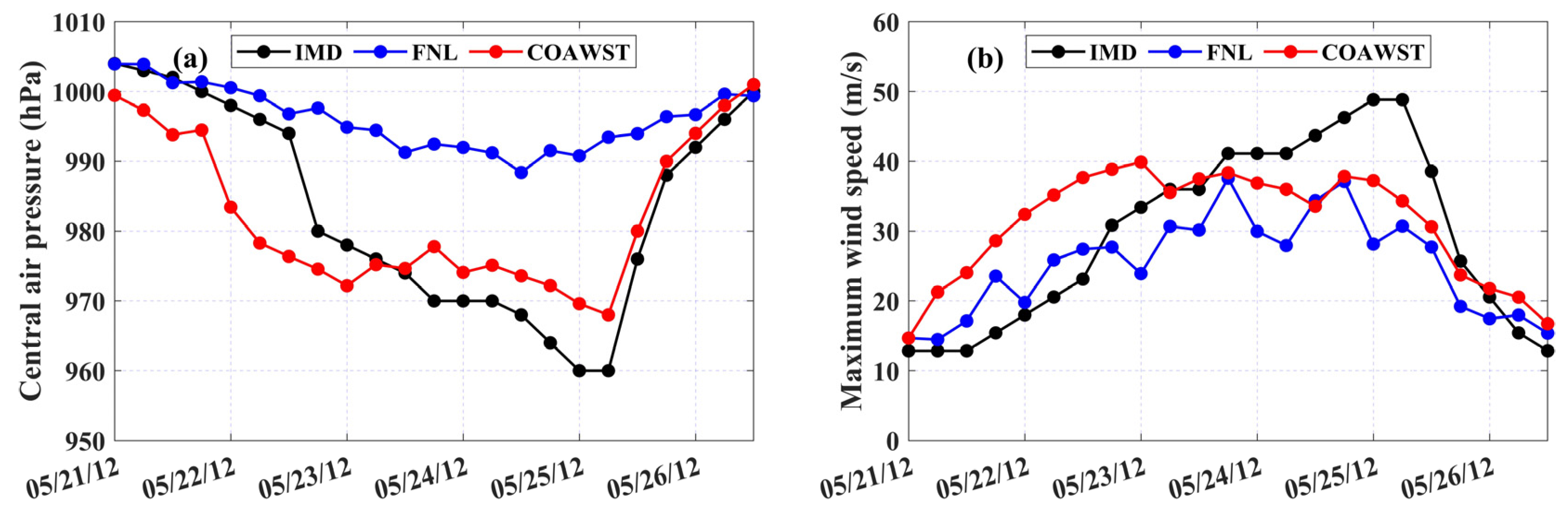
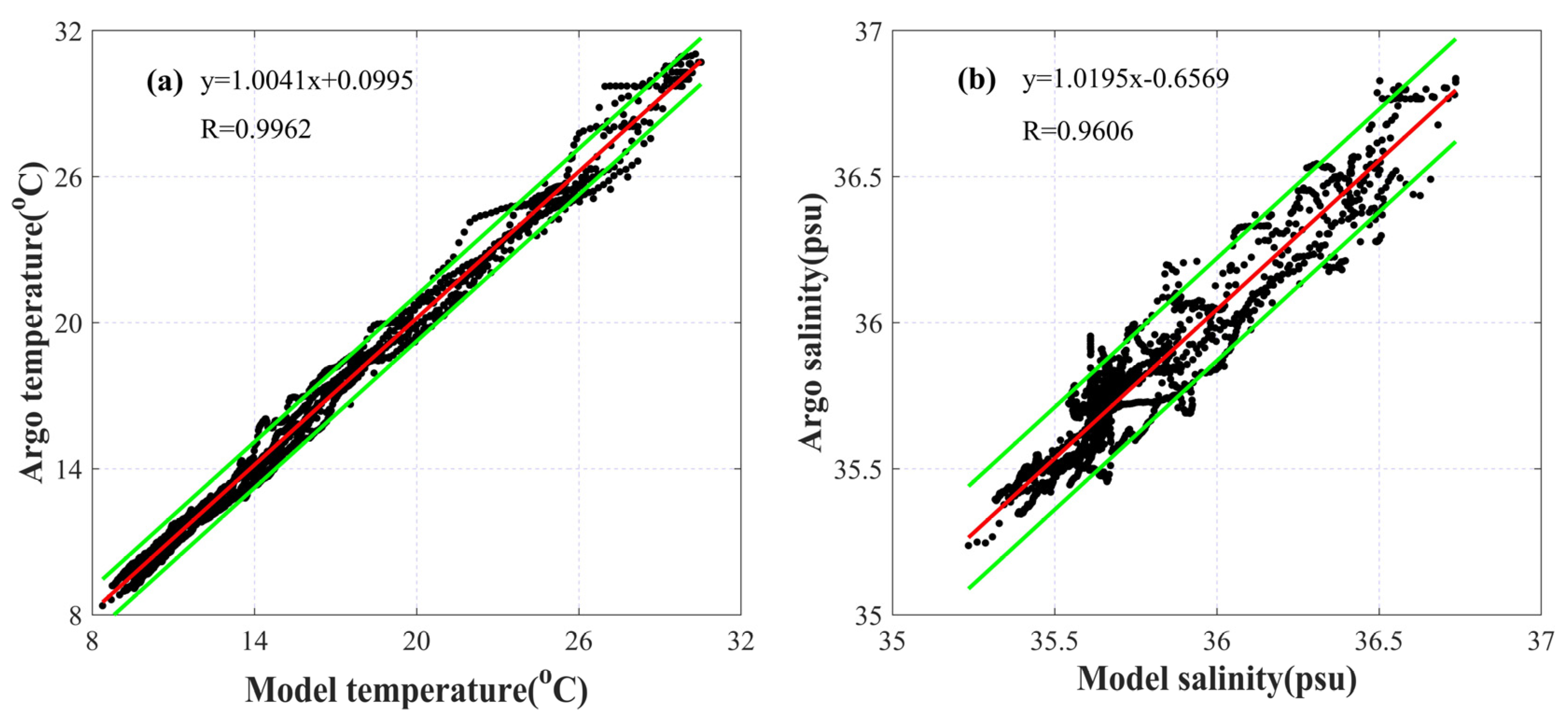
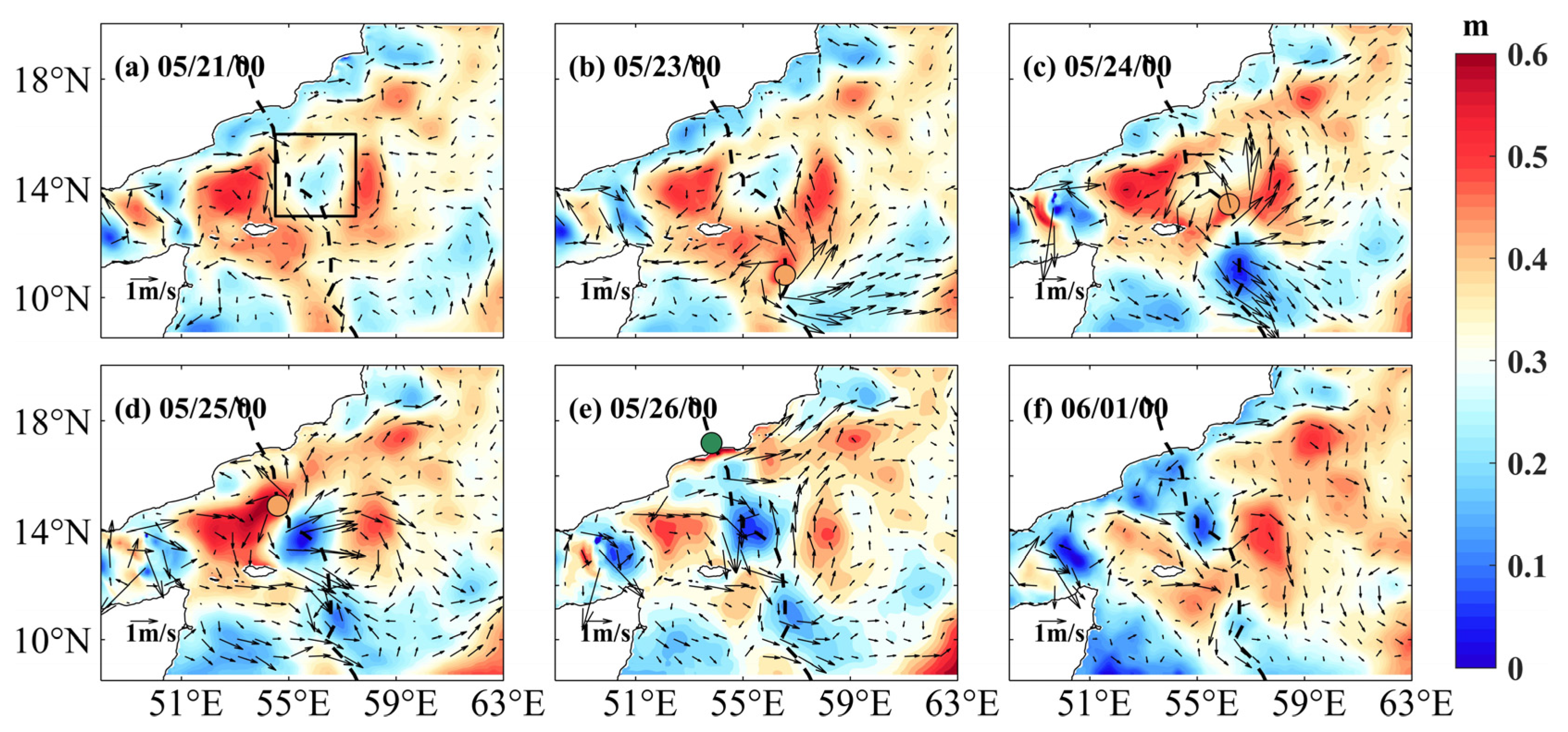
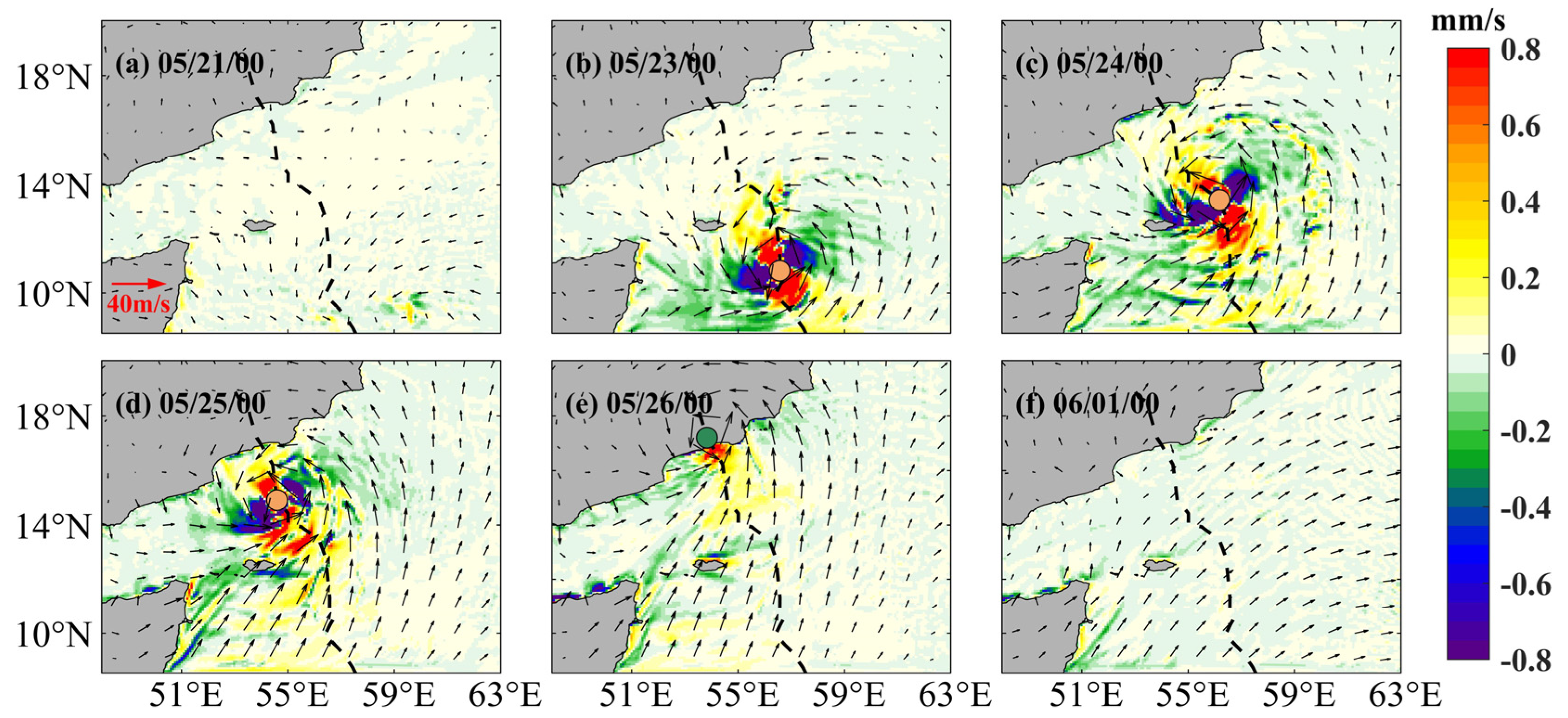

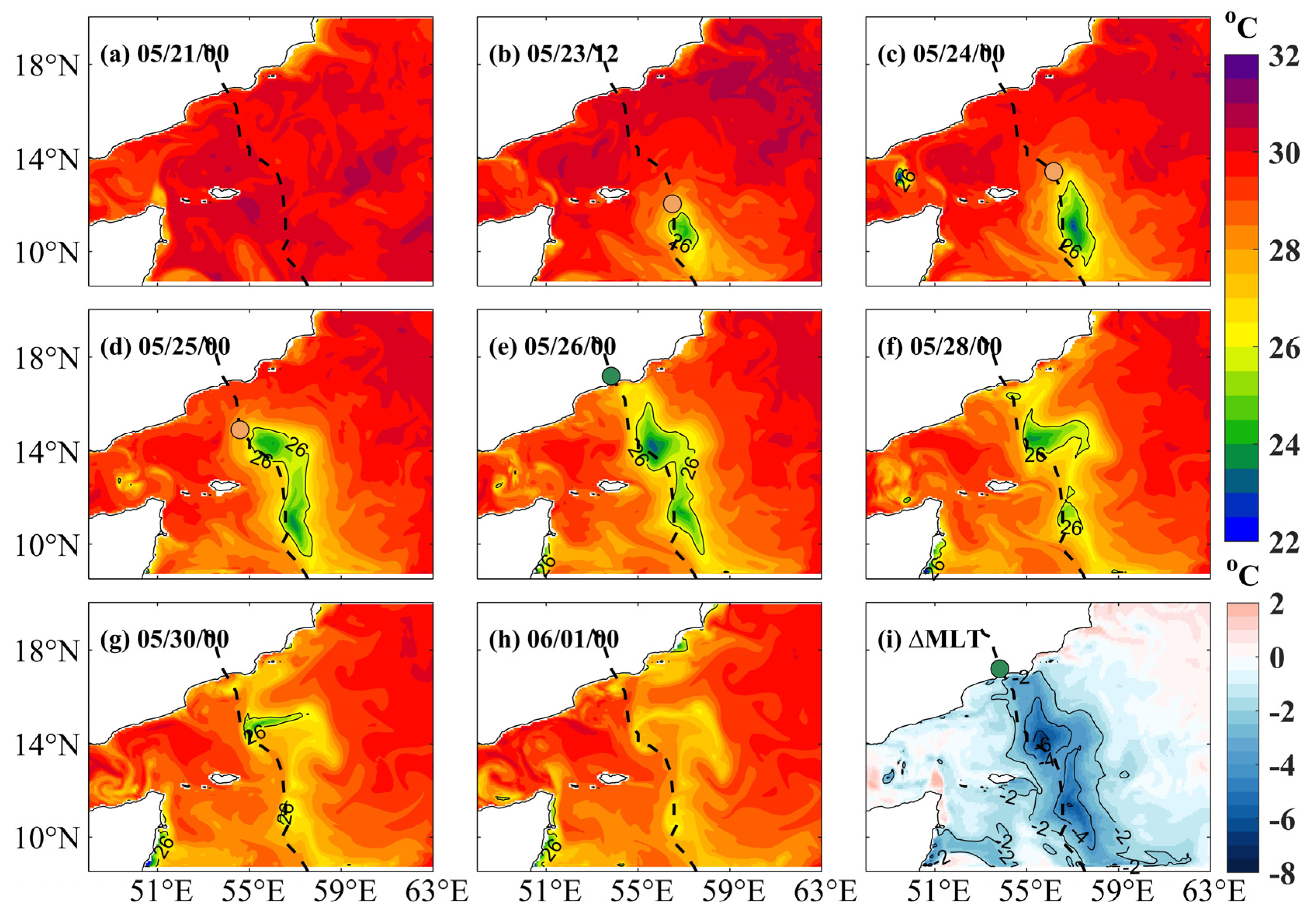
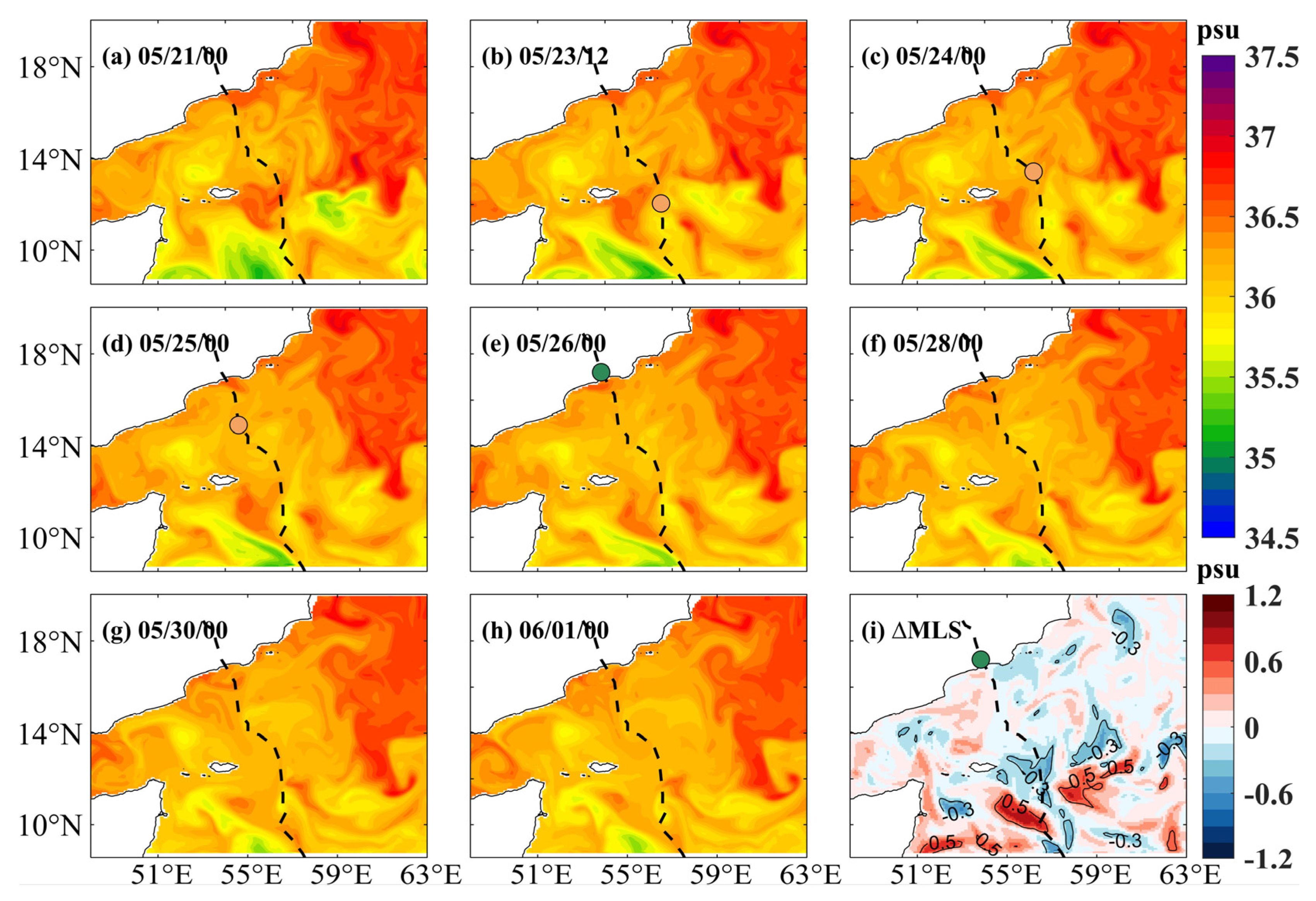
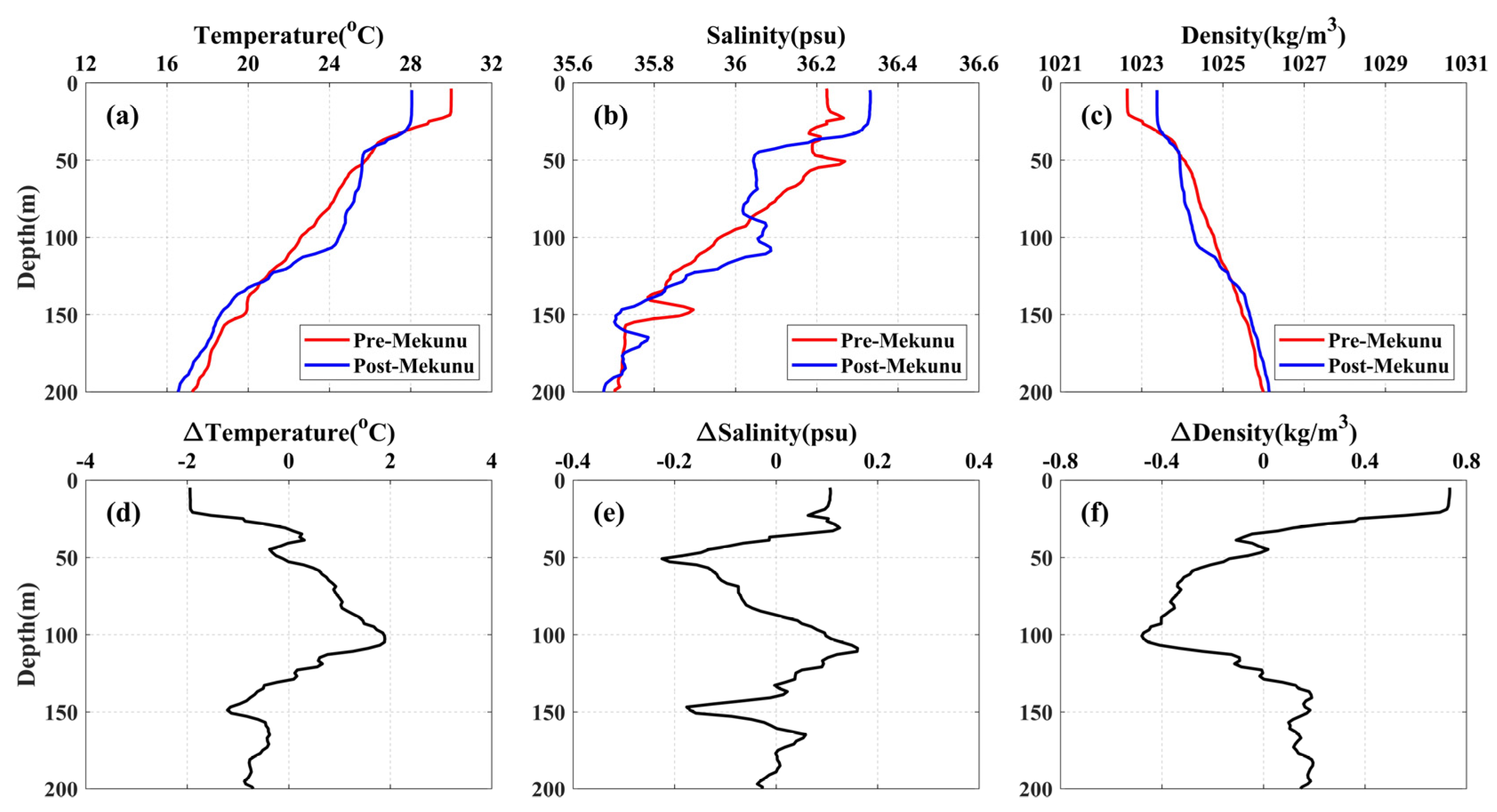
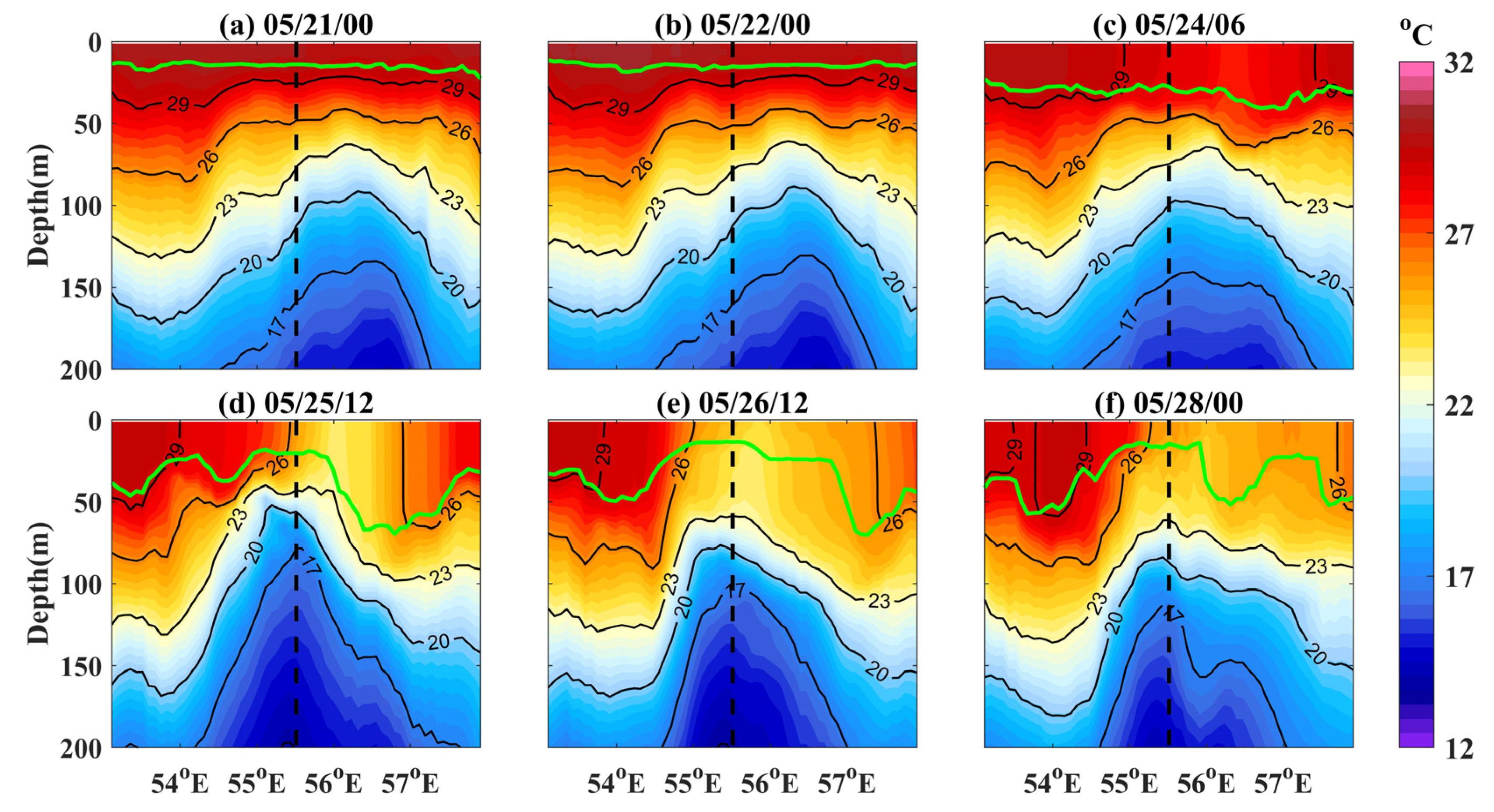

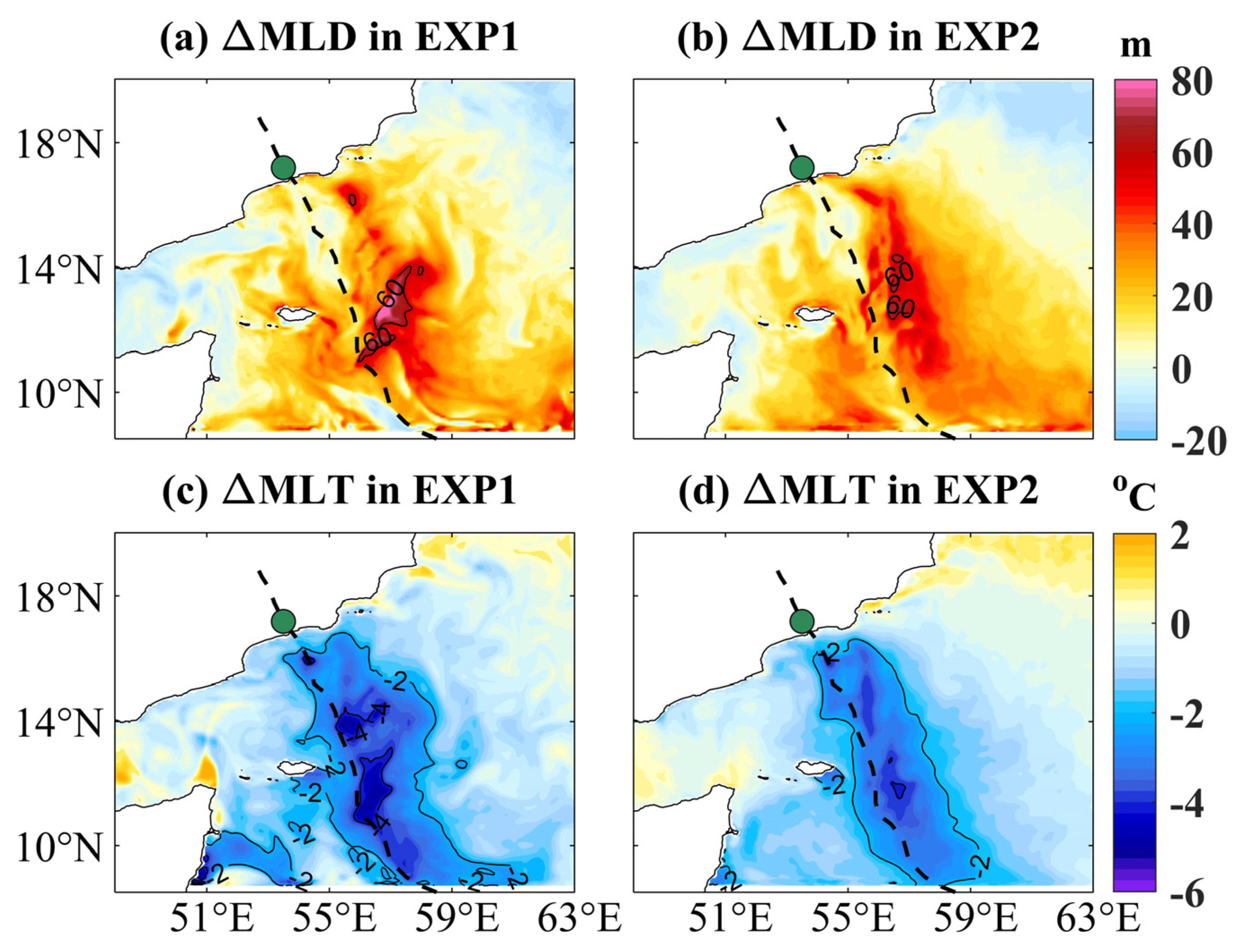
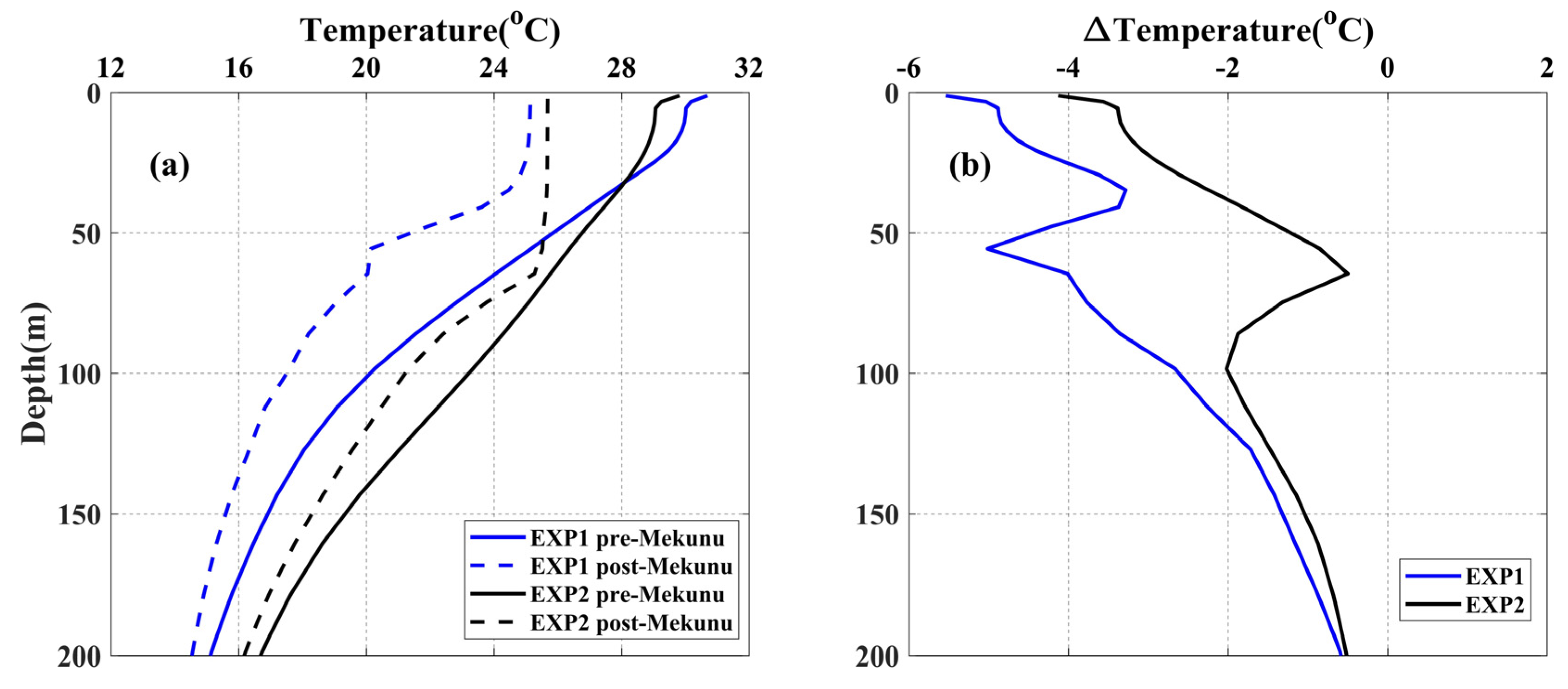
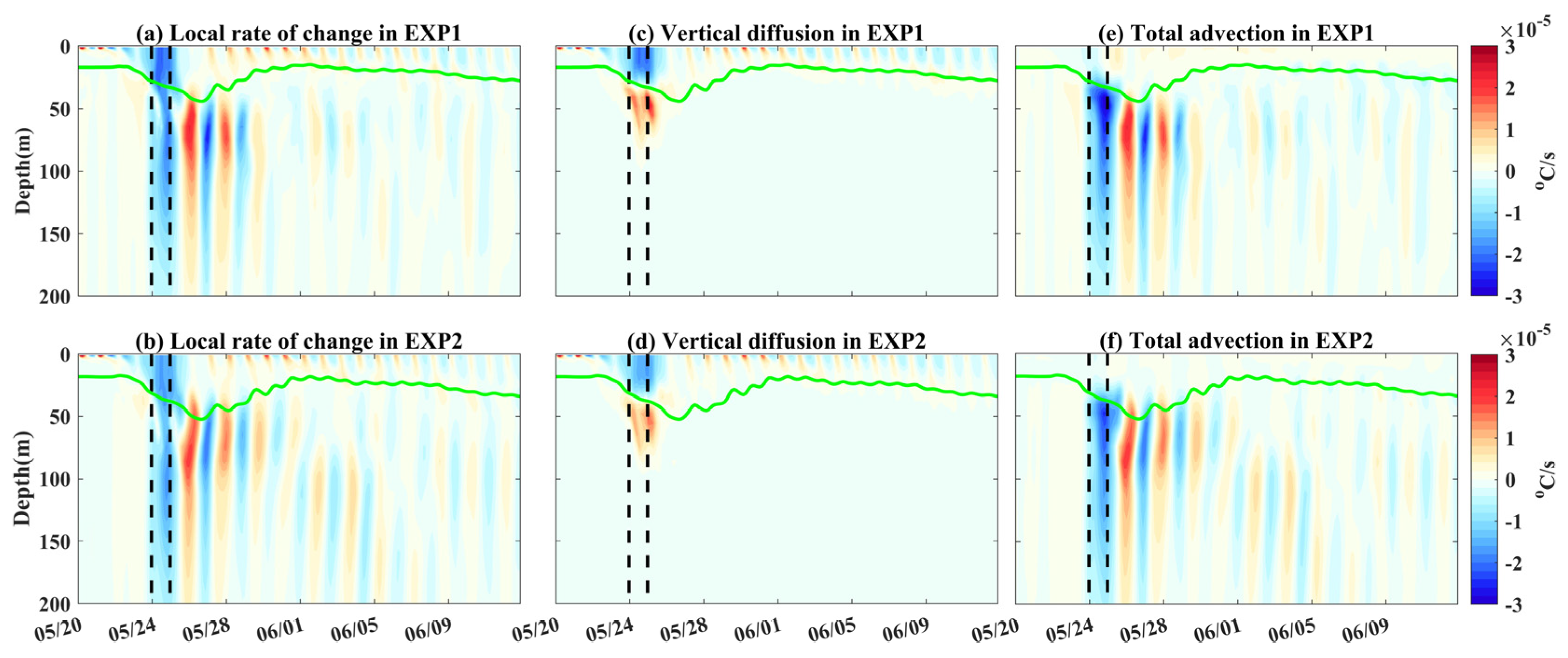
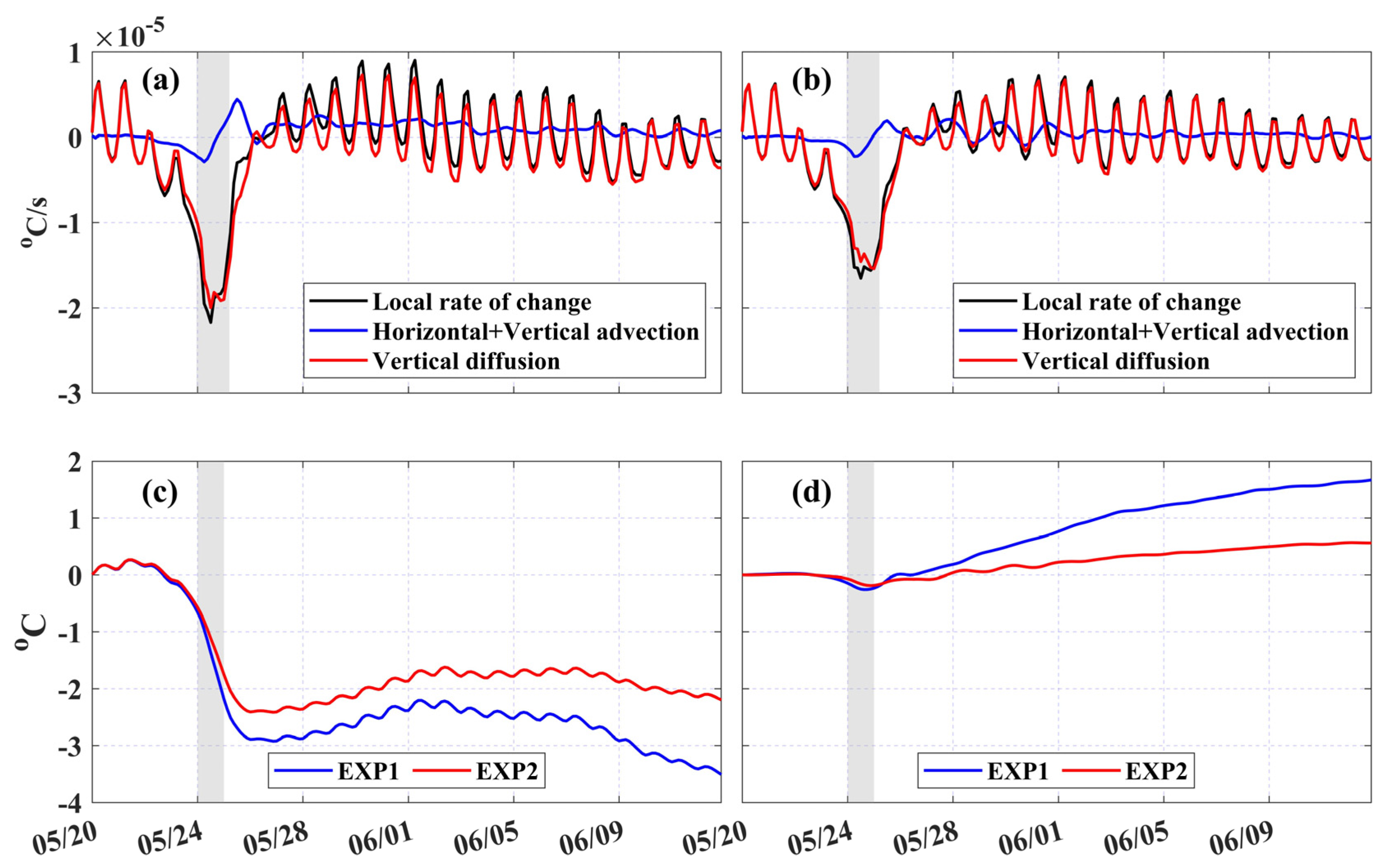
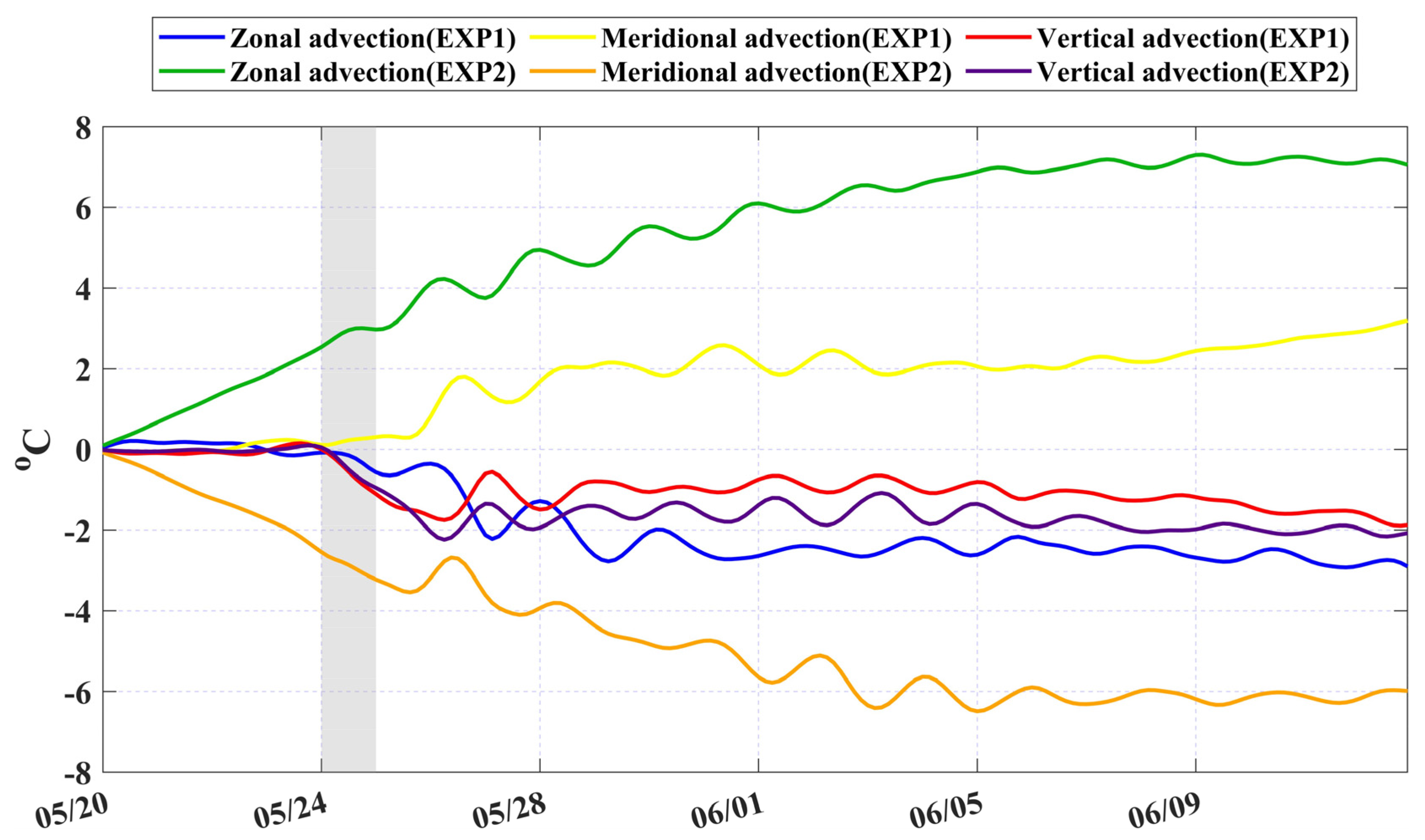
| Parameter | Scheme |
|---|---|
| Near surface layer | Monin–Obukhov |
| Land surface | Noah |
| Planetary boundary layer | YSU |
| Longwave radiation | RRTM |
| Shortwave radiation | Dudhia |
| Microphysics | WSM3 |
| Cumulus convection | Kain–Fritsch |
| Date | MLD (m) | MLT (°C) | MLS (psu) |
|---|---|---|---|
| 21 May 2018 | 21.2 | 30.0 | 36.2 |
| 31 May 2018 | 30.0 | 28.0 | 36.3 |
| Experiment | SSH (m) | MLD (m) | D26 (m) |
|---|---|---|---|
| EXP1 | 0.31 | 17.04 | 51.26 |
| EXP2 | 0.36 | 18.16 | 56.34 |
Disclaimer/Publisher’s Note: The statements, opinions and data contained in all publications are solely those of the individual author(s) and contributor(s) and not of MDPI and/or the editor(s). MDPI and/or the editor(s) disclaim responsibility for any injury to people or property resulting from any ideas, methods, instructions or products referred to in the content. |
© 2024 by the authors. Licensee MDPI, Basel, Switzerland. This article is an open access article distributed under the terms and conditions of the Creative Commons Attribution (CC BY) license (https://creativecommons.org/licenses/by/4.0/).
Share and Cite
Ren, D.; Han, S.; Wang, S. Upper Ocean Responses to Tropical Cyclone Mekunu (2018) in the Arabian Sea. J. Mar. Sci. Eng. 2024, 12, 1177. https://doi.org/10.3390/jmse12071177
Ren D, Han S, Wang S. Upper Ocean Responses to Tropical Cyclone Mekunu (2018) in the Arabian Sea. Journal of Marine Science and Engineering. 2024; 12(7):1177. https://doi.org/10.3390/jmse12071177
Chicago/Turabian StyleRen, Dan, Shuzong Han, and Shicheng Wang. 2024. "Upper Ocean Responses to Tropical Cyclone Mekunu (2018) in the Arabian Sea" Journal of Marine Science and Engineering 12, no. 7: 1177. https://doi.org/10.3390/jmse12071177





